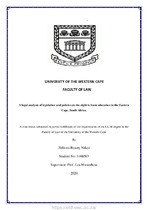| dc.description.abstract | The right to a basic education is recognised as an essential right in international and regional law, with numerous instruments regulating it.1 There are soft laws, in the form of General Comment documents, which provide guidelines to interpreting this right.2 Among these instruments, for example, the International Covenant on Social, Economic and Cultural Rights (hereafter referred to as ‘the ICESCR’) and the African Charter on Human and People’s Rights (hereafter referred to as ‘the ACHPR’) implore member states to ensure that every child within their jurisdiction is able to gain access to education.3 The ICESCR acknowledges that basic education as a socio-economic right is realisable overtime, its full realisation dependent on the availability of state resources.4 Furthermore, the state is required to ensure that ‘scientific and technical knowledge’ is made accessible, thus incorporating modern teaching and learning methods.5 In addition, the state is called to ensure that the quality of their education is acceptable and of a similar standard in all of their public schools.6 Moreover, the Convention on the Rights of the Child (hereafter referred to as the ‘CRC) and the African Charter on the Rights and Welfare of the Child (hereafter referred to as the ‘ACRWC’) require the state to take measures that will encourage learners to attend school regularly and thus reduce the dropout rates.7 These instruments lay down normative standards, giving guidance on the content of the right to basic education, i.e. defining what availability, accessibility, acceptability, and the adaptability (4As) means within the broader context of the right to basic education.
The right to a basic education, in theory is immediately realisable; however in practice, it can be argued that it is being treated like other socio-economic rights, subjected to the principle of progressive realisation.8 This right, unlike other socio-economic rights in South Africa, is sui generis, it has no internal qualifiers, meaning that it can only be limited in terms of a law of general application that is reasonable and justifiable in an open and democratic society founded on human dignity, freedom and equality.9As a party to most of the above instruments, the post-apartheid government of South Africa through its Constitution10, has entrenched the right to basic education under section 29(1)(a). Through this constitutional recognition, numerous legislation and policy documents have been enacted, which directly deal with the implementation of this right.11 Accordingly, the following selected legal instruments have been essential tools used to assist the relevant stakeholders with defining and implementing the right to a basic education , not just at the national level but also provincially.12 These instruments are the South African Schools Act,13 National Education Policy Act14 and the Employment of Educators Act,15 which are the main statutes on basic education. In addition, the Eastern Cape Schools Education Act,16 Promotion of Equality and Prevention of Unfair Discrimination Act,17 Children's Act,18 Criminal Law (Sexual Offences and Related Matters) Amendment Act,19 Criminal Procedure Act and the Refugees Act,20 which shall be discussed in detail in chapter 4 of the study When assessing the availability, accessibility, and the acceptability of basic education resources in the Eastern Cape (hereafter referred to as ‘the EC’), the province appears to be lagging when compared to some of the other provinces. For instance, the National Education Infrastructure Management System Report (hereafter referred to as ‘NEIMSR’) stated that out of the 5393 schools audited from the EC, 1945 of these schools had pits and 37 had no sanitation facilities21. In addition, 92.99% of the 5393 schools in the province do not have libraries and 4.21 % of the schools recorded have adequately resourced libraries.22 This is to be contrasted to 63.24% schools that have libraries in Gauteng.23 In addition, the illiteracy rate in the province is estimated at 10, 4% when compared to other provinces, which is against the background that the province has experienced a decline in learner enrolment over the last few years. | en_US |

